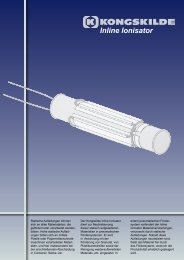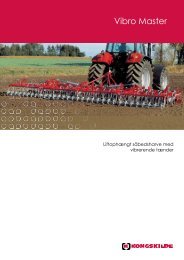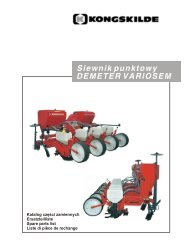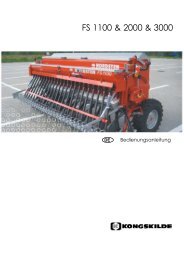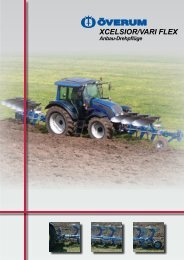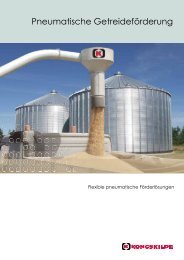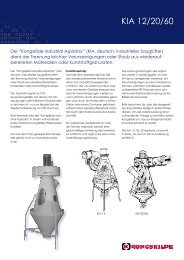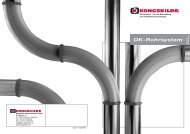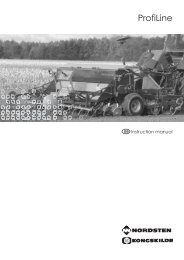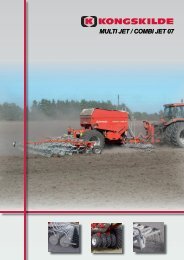Conveying Capacity - Kongskilde
Conveying Capacity - Kongskilde
Conveying Capacity - Kongskilde
Create successful ePaper yourself
Turn your PDF publications into a flip-book with our unique Google optimized e-Paper software.
<strong>Conveying</strong> <strong>Capacity</strong><br />
The conveying capacity depends<br />
on the piping layout and the type of<br />
material to be conveyed.<br />
In the examples the conveying capacities<br />
apply to materials with the<br />
following specific gravities:<br />
Specific gravity<br />
Material kg/m 3<br />
Barley .......................................670<br />
Wheat .......................................750<br />
Oats ..........................................500<br />
Rye ...........................................700<br />
Maize ........................................700<br />
Rape .........................................700<br />
Peas .........................................800<br />
The capacities are based on precleaned<br />
material with a moisture<br />
content of 15% (grain, maize and<br />
peas) or 9% (rape). Unclean crops<br />
and higher moisture contents will<br />
reduce the capacities.<br />
The tables on page 8 show the<br />
conveying capacities for barley, rye,<br />
oats and maize with three different<br />
types of standard suction pipelines<br />
and one standard pressure pipeline.<br />
The tables on page 12 show<br />
corresponding capacities for wheat,<br />
rape and peas.<br />
Each table gives the capacities of<br />
the different blower sizes at different<br />
conveying distances.<br />
The conveying distance is the total<br />
length of all horizontal and vertical<br />
piping on the suction and pressure<br />
side. The length of suction hose<br />
is included, but bends and suction<br />
head are not taken into account.<br />
If a long suction head is used, the<br />
conveying distance must be increased<br />
by 1.5 m. For each extension<br />
there will be a further increase<br />
of 0.65 m.<br />
Pneumatic conveying is based on<br />
the use of atmospheric air to carry<br />
the crops through the pipelines.<br />
Thus factors influencing the air<br />
condition (temperature, barometric<br />
pressure) will also effect the conveying<br />
capacity. The capacities<br />
shown are based on a barometric<br />
pressure of approx. 760 mm Hg<br />
and an air temperature of 20 C.<br />
The examples given are only intended<br />
as a guide as many other<br />
factors may affect the capacity.<br />
8<br />
<strong>Conveying</strong> capacities in barley, rye, oats and maize<br />
Table 1<br />
Suction pipeline<br />
One horizontal universal suction head<br />
One 2.5 m polyurethane suction hose, straight<br />
Two 2 m steel flexible suction hoses<br />
Pressure pipeline<br />
A number of metres of horizontal piping<br />
4 m vertical piping<br />
Two 90° bends<br />
One outlet cyclone<br />
<strong>Conveying</strong> <strong>Conveying</strong> capacities in barley, rye, oats and maize (t/h)<br />
distance<br />
(metres) 10 20 30 40 50 60 80 100 120 150 200<br />
SUC 100E 4.5 4.0 3.5 3.1 2.7 2.4 1.8 1.4 0.9 0.5<br />
SUC 150E 7.8 7.1 6.5 6.0 5.5 5.0 4.2 3.6 3.0 2.3<br />
SUC 200E 10.1 9.3 8.5 7.9 7.3 6.8 5.9 5.1 4.4 3.6 2.5<br />
SUC 300E 14.0 12.9 11.9 11.0 10.2 9.5 8.3 7.2 6.4 5.3 4.0<br />
SUC 500E 22.5 20.9 19.6 18.3 17.2 16.2 14.4 13.0 11.7 10.1 8.1<br />
Table 2<br />
Suction pipeline<br />
One horizontal universal suction head arranged at an angle of 45°<br />
One 2 m steel flexible suction hose<br />
Pressure pipeline<br />
A number of metres of horizontal piping<br />
4 m vertical piping<br />
Two 90° bends<br />
One outlet cyclone<br />
<strong>Conveying</strong> <strong>Conveying</strong> capacities in barley, rye, oats and maize (t/h)<br />
distance<br />
(metres) 10 20 30 40 50 60 80 100 120 150 200<br />
SUC 100E 6.8 6.0 5.2 4.6 4.0 3.5 2.7 2.0 1.5 0.8<br />
SUC 150E 11.5 10.3 9.3 8.4 7.6 6.9 5.7 4.8 4.0 3.0<br />
SUC 200E 14.7 13.3 12.0 11.0 10.0 9.2 7.8 6.7 5.7 4.6 3.1<br />
SUC 300E 19.6 17.7 16.0 14.6 13.3 12.3 10.5 9.0 7.8 6.4 4.7<br />
SUC 500E 31.8 28.9 26.5 24.4 22.6 21.0 18.3 16.1 14.3 12.2 9.5<br />
Table 3<br />
Suction pipeline<br />
One vertical universal suction head<br />
One 90° bend<br />
2 m horizontal piping<br />
Pressure pipeline<br />
A number of metres of horizontal piping<br />
4 m vertical piping<br />
Two 90° bends<br />
One outlet cyclone<br />
<strong>Conveying</strong> <strong>Conveying</strong> capacities in barley, rye, oats and maize (t/h)<br />
distance<br />
(metres) 10 20 30 40 50 60 80 100 120 150 200<br />
SUC 100E 7.3 6.3 5.5 4.8 4.2 3.7 2.8 2.1 1.5 0.8<br />
SUC 150E 12.4 11.0 9.9 8.8 8.0 7.2 6.0 4.9 4.1 3.1<br />
SUC 200E 15.8 14.2 12.8 11.6 10.6 9.7 8.1 6.9 5.9 4.7 3.2<br />
SUC 300E 21.0 18.8 16.9 15.4 14.0 12.8 10.9 9.3 8.1 6.6 4.8<br />
SUC 500E 34.2 30.9 28.2 25.8 23.8 22.0 19.1 16.8 14.9 12.6 9.8



